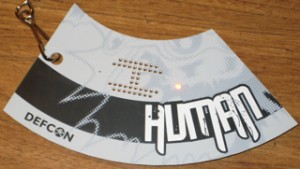I like DEFCON. I like Dark Tangent personally. I like Joe Grand, the guy who has designed the DEFCON badges for the past few years.
But, guys, it looks really bad when, for the second year in a row, you run out of badges early on Thursday and have to issue temporary badges until more real ones get to the con Friday morning. You don’t even have the Olympics to blame this year. This is especially frustrating now that badge hacking is an official event/contest.
DEFCON talks I will not be attending:
“Hacking UFOlogy 102: The Implications of UFOs for Life, the Universe, and Everything.”
“Two years ago at Def Con 15, Richard [Thieme] presented Hacking UFOlogy. He supported his contention that (1) UFOs are real and (2) the data to support that statement is voluminous with numerous references and links…”
Hippie, please.
DEFCON talks I plan to attend:
“Is your iPhone Pwned”, Mahaffrey, Hering, and Lineberry. (This may be tough to get into, but it is scheduled against Dark Tangent’s intro and Joe Grand’s discussion of the badge, so we’ll see.)
“Hacking with the iPod Touch”, Willhelm
“That Awesome Time I Was Sued For Two Billion Dollars”, Scott
“Three Point Oh”, Long. (For the speaker’s reputation; I’ve heard Johnny Long speak before, and he’s someone I’d like to know better.)
“Something About Network Security”, Kaminsky. (Again, for the speaker’s reputation; Kaminsky is to TCP/IP what Musashi was to the sword.)
“Hacker vs. Disasters Large & Small”, RenderMan and Schearer
“Personal Survival Preparedness”, Dunker and Dunker
“Picking Electronic Locks Using TCP Sequence Prediction”, Lawshae
“Sniff Keystrokes With Lasers/Voltmeters”, Barisani and Bianco
“Bluetooth, Smells Like Chicken”, Spill, Ossmann, and Steward. (It looks like they’re going to talk about using software-defined radio to sniff Bluetooth, techniques for breaking the pseudo-random hopping sequence, and apparently some stuff that can be done with sub-$10 off-the-shelf hardware.)
“RAID Recovery: Recover Your PORN By Sight and Sound”, Moulton
“USB Attacks”, Vega
“Cracking 400,000 Passwords, Or How To Explain to Your Roomate why the Power Bill Is a Little High”, Weir and Aggarwal
I missed the panels on “Hacking With GNURadio” and “Hacking the Apple TV and Where your Forensic Data Lives”. Perhaps next year I need to arrive on Wednesday. If there is a next year.




